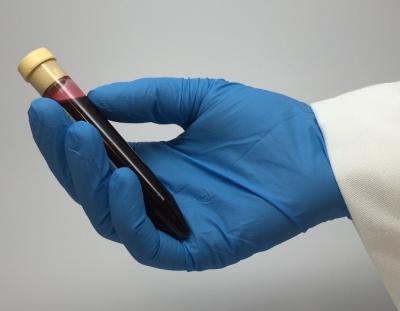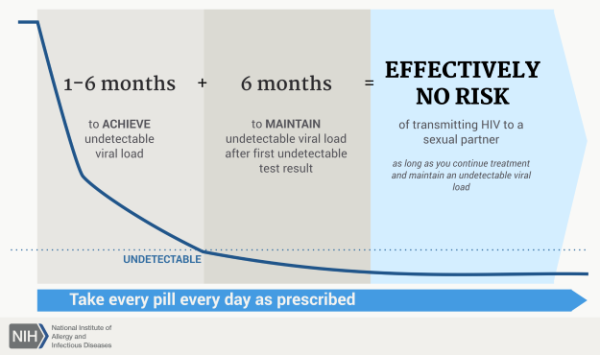
A vial of blood
Development of antiretroviral drugs to treat HIV has turned what was once an almost always fatal infection into a manageable chronic condition. Antiretroviral therapy can reduce the amount of HIV in the blood to levels that are undetectable with standard tests. NIAID-supported research has demonstrated that achieving and maintaining a “durably undetectable” viral load (the amount of HIV in the blood) not only preserves the health of the person living with HIV, but also prevents sexual transmission of the virus to people without HIV.
What is viral suppression?
Antiretroviral therapy keeps HIV from making copies of itself. For almost everyone who starts taking their HIV medication as prescribed, viral load will drop to an undetectable level in six months or less. Continuing to take HIV medications as directed is imperative to stay undetectable.
What does it mean to be durably undetectable?
Taking antiretroviral therapy as prescribed to suppress the amount of HIV in the blood to levels that are undetectable with standard tests. A person is considered to have a “durably undetectable” HIV viral load if their viral load remains undetectable for at least six months after their first undetectable test result.
Does being durably undetectable mean that the virus has left my body?
Even when viral load is undetectable, HIV is still present in the body. The virus lies dormant inside a small number of cells in the body called viral reservoirs. When therapy is interrupted for any reason, the virus begins to multiply, becoming detectable in the blood again. This newly reproducing virus can be transmitted to others in the absence of other prevention methods.
How does being durably undetectable affect my risk of transmitting HIV to a sexual partner?
People with HIV who take antiretroviral medications as prescribed and who achieve and then maintain an undetectable viral load have effectively no risk of sexually transmitting the virus to people without HIV.
Three large multinational research studies involving couples in which one partner was living with HIV and the other was not—HPTN 052, PARTNER and Opposites Attract—observed no HIV transmission to the HIV-negative partner while the partner with HIV had a durably undetectable viral load. These studies followed approximately 3,000 male-female and male-male couples over many years while they did not use condoms. Over the course of the PARTNER and Opposites Attract studies, couples reported engaging in more than 74,000 condomless episodes of vaginal or anal intercourse.
Learn more about HIV treatment as prevention.
After I begin HIV treatment, how long does it take for the risk of sexually transmitting HIV to become effectively zero?
There is effectively no risk of sexual transmission of HIV when the partner living with HIV has achieved an undetectable viral load and then maintained it for at least six months. Most people who start taking antiretroviral therapy as prescribed achieve an undetectable viral load within one to six months after beginning treatment.
A person’s viral load is considered “durably undetectable” when all viral load test results are undetectable for at least six months after their first undetectable test result. This means that most people will need to be on treatment for 7 to 12 months before they reach a durably undetectable viral load.

What happens if I stop taking antiretroviral therapy?
When therapy is interrupted for any reason, the virus begins to multiply, becoming detectable in the blood again. This newly reproducing virus can be transmitted to others in the absence of other prevention methods. NIAID-supported research has provided clear-cut scientific evidence to support the benefits of staying on continuous antiretroviral treatment. In 2006, NIAID’s large clinical trial called SMART showed that people receiving intermittent antiretroviral treatment had twice the rate of disease progression compared to those receiving continuous treatment.
Taking antiretroviral treatment as directed to achieve and maintain durably undetectable status stops HIV from progressing, helping people stay healthy and live longer, while offering the benefit of preventing sexual transmission. Stopping and re-starting treatment can cause drug resistance to develop, making that treatment regimen ineffective and limiting future treatment options.
How often do I need to be tested to confirm that I’m durably undetectable?
According to U.S. HIV treatment guidelines, viral load typically should be measured every three to four months. People with HIV should talk with their health care teams to determine an appropriate schedule for viral load testing.
What are viral load “blips”?
Even if a person is durably undetectable and taking antiretroviral therapy as prescribed, they may experience small, temporary increases in viral load called “blips” followed by a decrease back to undetectable levels. Having a blip is relatively common and does not indicate that antiretroviral therapy has failed to control the virus. Scientists are working to better understand what causes blips.
How do I talk to my partner about their risk of acquiring HIV?
People with HIV can involve their partners in their treatment plans. Research shows that support from loving relationships and from the community can help individuals take medication as prescribed
Pre-exposure prophylaxis (PrEP), in which a person without HIV-negative takes antiretroviral drugs to prevent them from acquiring HIV, may be part of the conversation. Learn more about PrEP.
Do I still need to worry about other sexually transmitted infections?
HIV treatment and PrEP do not prevent other sexually transmitted infections, or STIs.
Ways to reduce the risk of STIs include having both partners tested and using condoms. Vaccines are available to prevent some STIs, including hepatitis B and human papillomavirus. A NIAID-supported study showed oral doxycycline given within 72 hours of condomless sex—better known as DoxyPEP—reduced the incidence of common bacterial STIs by two-thirds among study participants. A separate study showed DoxyPEP did not work in women. The Centers for Disease Control and Prevention published DoxyPEP guidelines in 2024.


